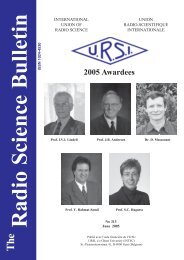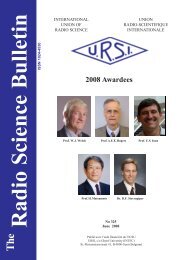December 2012 - URSI
December 2012 - URSI
December 2012 - URSI
Create successful ePaper yourself
Turn your PDF publications into a flip-book with our unique Google optimized e-Paper software.
Book Reviews for Radioscientists<br />
[Editor’s note: The Young Scientists who received an award at the 2011 Istanbul <strong>URSI</strong> GASS were asked to review their<br />
favorite textbook, even if it was a classic book. This is in contrast to our usual reviews, where we try to have new books<br />
reviewed. The reviews in this issue are from Young Scientists.]<br />
RF Microelectronics<br />
By by Behzad Razavi, Upper Saddle River, NJ, Prentice Hall, 1998; ISBN: 0-13-887571-5 [new edition: 2011]<br />
RF and microwave wireless communications have<br />
become popular and been part of modern life: applications<br />
include radios, cellular systems, and satellite systems.<br />
RF engineering has become important and critical in the<br />
wireless industry, which basically can be divided into system<br />
design and hardware development. RF engineers should<br />
have knowledge and technical skills in both fields. This<br />
book presents the basic concepts of RF architecture and<br />
circuit design. It can be regarded as an advanced textbook<br />
for microelectronics and analog circuits, as most of the<br />
presented concepts can be realized by various technologies,<br />
such as CMOS and MMIC. This book demonstrates the<br />
methods for implementing wireless systems through circuit<br />
design. It details core components of RF systems, including<br />
transceivers and amplifiers, which are essential to RF<br />
circuits. Hence, this is an extremely useful book for RF folk.<br />
This book can be divided into three parts: 1) background<br />
and basics of wireless and RF design (Chapters 1-2);<br />
2) overview of communication systems, including<br />
modulation and multiple-access techniques (Chapters 3-4);<br />
3) RF systems and components (Chapters 5-9). Although<br />
communication systems may be learned by a different path,<br />
the author of this book provides readers a good way to be<br />
familiar with the design process, and to verify the accuracy of<br />
the RF design by referring to the theory of communications.<br />
Readers can thus understand how the theory and formulation<br />
are implemented by the RF integrated circuit.<br />
Chapter 1, “Introduction to RF and Wireless<br />
Technology,” describes multiple disciplines used in<br />
RF design such that an RF system is an integration of<br />
communication theory, system architecture, and IC design.<br />
An “RF design hexagon” shows the tradeoffs among design<br />
parameters in order to meet specified targets. Since the same<br />
concept can be applied to many applications, experience<br />
is usually a key to making the decision in engineering to<br />
balance performance, cost, and scheduling of products.<br />
Chapter 2, “Basic Concepts in RF Design,” describes<br />
the nonlinearity and time variability of the components<br />
themselves, and then migrates to interference among<br />
components. Many effects of nonlinearities, such as<br />
harmonics, desensitization, and intermodulation, are key<br />
factors in determining and debugging the accuracy of<br />
outputs. Inter-symbol interference in a linear system results<br />
in signal distortion due to insufficient bandwidth; Nyquist<br />
signaling is then introduced to reduce that impact. After<br />
briefly reviewing random processes, noise and dynamic<br />
range are explained. It is shown how these two terms<br />
provide a straight way for evaluating the performance of<br />
the system and of circuit designs.<br />
Chapter 3, “Modulation and Detection,” presents<br />
the work performed by the RF transceiver, as a bridge<br />
between RF and baseband. The pros and cons of analog<br />
and digital modulations are emphasized, which reflects<br />
on the merits and limitations in the design of RF circuits.<br />
Each of these can provide unique signal quality, spectral<br />
efficiency, and power efficiency. Optimum detection, and<br />
why non-coherent detection is adopted in many RF systems,<br />
are well introduced.<br />
Chapter 4, “Multiple Access Techniques and Wireless<br />
Standards,” describes how to build communications between<br />
multiple transceivers, and what rules to follow in various<br />
wireless systems. Definitions of general behaviors and<br />
phenomena in mobile RF communications are given first.<br />
The difference between TDD and FDD is explained. FDMA,<br />
TDMA, and different types of CDMA are then introduced.<br />
This is followed by 2G and 3G cellular systems, where<br />
power control and diversity are briefly reviewed.<br />
Chapter 5, “Transceiver Architectures,” explains<br />
the criteria for selecting transceivers, such as bandwidth,<br />
in-band loss, IP3, noise, sensitivity, and dynamic range.<br />
Various receiver and transmitter architectures are reviewed.<br />
The superiority of popularly used heterodyne receivers,<br />
and the design concerns of spectrum image and IF issues,<br />
are analyzed in great detail. Image-rejection techniques are<br />
included, as well. Homodyne receivers are compared here.<br />
Transmitters bridging baseband, RF, and the antenna are<br />
then explained. The duplexer and switch in the RF front<br />
end, used to separate the transmitted and received signals,<br />
sometimes yield losses that cannot be compensated for in<br />
the system. This chapter is concluded with some examples<br />
of actual products used in FM and GSM radios.<br />
Chapter 6, “Low-Noise Amplifiers and Mixers,”<br />
presents their implementations using bipolar and CMOS<br />
technologies, which are suitable for VLSI. The low-noise<br />
amplifier’s performance is governed not only by the imagerejection<br />
filter and mixer, but is also limited by the impedance<br />
matching for the antenna. The noise behavior, power gain,<br />
30 The Radio Science Bulletin No 343 (<strong>December</strong> <strong>2012</strong>)
















